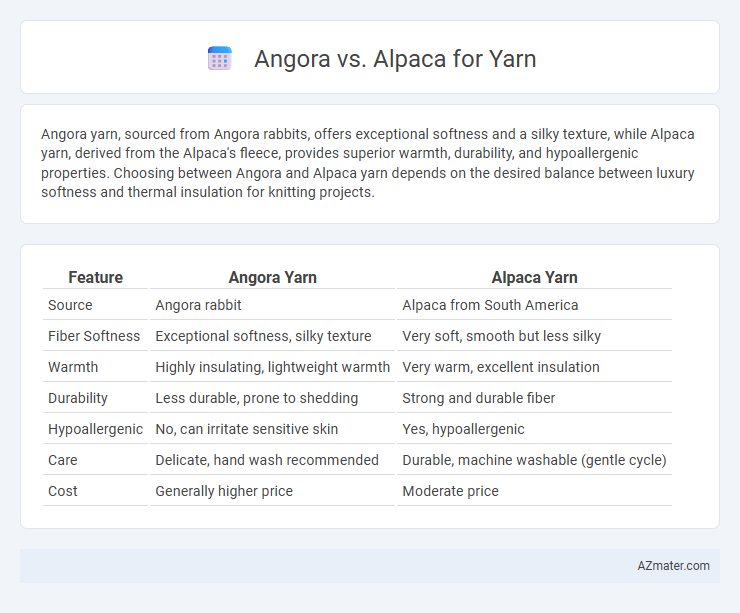Angora yarn, sourced from Angora rabbits, offers exceptional softness and a silky texture, while Alpaca yarn, derived from the Alpaca's fleece, provides superior warmth, durability, and hypoallergenic properties. Choosing between Angora and Alpaca yarn depends on the desired balance between luxury softness and thermal insulation for knitting projects.
Table of Comparison
| Feature | Angora Yarn | Alpaca Yarn |
|---|---|---|
| Source | Angora rabbit | Alpaca from South America |
| Fiber Softness | Exceptional softness, silky texture | Very soft, smooth but less silky |
| Warmth | Highly insulating, lightweight warmth | Very warm, excellent insulation |
| Durability | Less durable, prone to shedding | Strong and durable fiber |
| Hypoallergenic | No, can irritate sensitive skin | Yes, hypoallergenic |
| Care | Delicate, hand wash recommended | Durable, machine washable (gentle cycle) |
| Cost | Generally higher price | Moderate price |
Introduction to Angora and Alpaca Yarn
Angora yarn is derived from the hair of Angora rabbits, known for its exceptional softness, lightweight texture, and lustrous sheen, making it highly prized for luxury garments. Alpaca yarn comes from the fleece of alpacas native to South America, offering a warm, durable, hypoallergenic fiber with a silky finish and excellent thermal properties. Both fibers are valued in the textile industry for their unique qualities, with Angora excelling in softness and Alpaca favored for warmth and strength.
Source and Origins of Angora and Alpaca Fibers
Angora fiber is harvested from Angora rabbits primarily raised in France, Turkey, and China, known for its exceptional softness and sheen, while alpaca fiber originates from the native alpacas of the Andean regions in Peru, Bolivia, and Chile, prized for its warmth and hypoallergenic properties. The Angora rabbit's coat is carefully sheared or plucked to obtain long, silky fibers, whereas the alpaca fleece is sheared annually, yielding a denser and warmer yarn. The distinct geographical and climatic conditions of Angora and alpaca sources influence the unique textures and qualities of their respective yarns.
Texture and Softness Comparison
Angora yarn, derived from Angora rabbits, offers an exceptionally silky and fluffy texture known for its lightweight warmth and luxurious softness. Alpaca yarn, sourced from alpacas, features a smooth, slightly less elastic fiber with a crisp softness that is warmer and more durable than sheep wool. While Angora provides a delicate, cloud-like softness ideal for luxury garments, Alpaca delivers robust softness with added strength suitable for long-lasting knitwear.
Warmth and Insulating Properties
Angora yarn, sourced from Angora rabbits, excels in warmth due to its hollow fiber structure that traps heat efficiently, making it one of the warmest natural fibers available. Alpaca yarn, derived from the alpaca animal, features dense, fine fibers that provide excellent insulation and moisture-wicking properties, ensuring warmth without overheating. Both fibers offer superior thermal regulation, but Angora's lightweight loftiness contrasts with Alpaca's durable insulating qualities, influencing their suitability for different cold-weather garments.
Durability and Strength Differences
Angora yarn, sourced from Angora rabbits, is prized for its softness but exhibits lower durability and tensile strength compared to alpaca yarn. Alpaca fibers, derived from the South American alpaca, offer superior strength and resistance to pilling, making them more suitable for garments requiring long-lasting wear. The inherent resilience of alpaca fibers ensures that yarns maintain structural integrity and shape over time, outperforming the more delicate angora in durability metrics.
Hypoallergenic Qualities
Alpaca yarn is renowned for its hypoallergenic properties due to the absence of lanolin, making it ideal for sensitive skin and allergy sufferers, whereas Angora yarn, derived from Angora rabbits, contains lanolin and may trigger allergies in some individuals. Alpaca fibers are smooth and less likely to cause irritation, providing a softer touch compared to Angora, which is fluffier but can shed fibers that irritate the skin. Choosing alpaca yarn ensures hypoallergenic comfort while maintaining warmth and durability in knitting projects.
Cost and Availability of Each Yarn
Angora yarn, derived from Angora rabbits, tends to be more expensive due to its limited supply and labor-intensive harvesting process compared to alpaca yarn, which is sourced from alpacas primarily raised in South America and offers a more abundant and consistent availability. Alpaca yarn is generally more affordable, reflecting its larger global production and established market presence, making it a cost-effective choice for knitters and textile manufacturers. While Angora yarn commands a premium price driven by its softness and luxury appeal, alpaca yarn balances quality with accessibility, offering a diverse range of textures and colors at a lower cost point.
Color Variety and Dye Affinity
Angora yarn offers a limited color variety, typically found in natural hues like white, gray, and beige, due to the delicate nature of mohair fibers which can affect dye uptake. Alpaca yarn, on the other hand, boasts a wider natural color palette ranging from white and cream to browns, grays, and black, providing excellent dye affinity that results in vibrant, long-lasting colors. The superior dye acceptance of alpaca fibers makes it a preferred choice for artisans seeking rich, diverse color options in high-quality yarns.
Best Uses and Project Suitability
Angora yarn, sourced from Angora rabbits, excels in lightweight, luxurious projects such as shawls, scarves, and delicate sweaters due to its silky texture and warmth. Alpaca yarn, obtained from the alpaca fiber, is best suited for durable garments like cardigans, blankets, and winter accessories, offering excellent insulation and a soft, hypoallergenic feel. Both fibers are prized in high-end knitting, but Angora's fluffiness enhances drape and softness while Alpaca's strength supports warmth and resilience in heavy-use items.
Sustainable and Ethical Considerations
Angora yarn production raises concerns due to animal welfare issues, as Angora rabbits are often subjected to stressful combing or shearing processes without adequate care. Alpaca fiber, sourced from wild-caught, free-ranging animals native to South America, offers a more sustainable and ethical option, emphasizing minimal environmental impact and humane treatment. Certifications like the Responsible Alpaca Standard ensure alpaca yarn aligns with eco-friendly and ethical standards, making it preferable for conscious consumers.

Infographic: Angora vs Alpaca for Yarn
 azmater.com
azmater.com